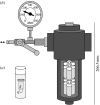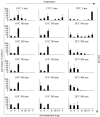The ocean is not deep enough: pressure tolerances during early ontogeny of the blue mussel Mytilus edulis
- PMID: 18986970
- PMCID: PMC2660949
- DOI: 10.1098/rspb.2008.1376
The ocean is not deep enough: pressure tolerances during early ontogeny of the blue mussel Mytilus edulis
Abstract
Early ontogenetic adaptations reflect the evolutionary history of a species. To understand the evolution of the deep-sea fauna and its adaptation to high pressure, it is important to know the effects of pressure on their shallow-water relatives. In this study we analyse the temperature and pressure tolerances of early life-history stages of the shallow-water species Mytilus edulis. This species expresses a close phylogenetic relationship with hydrothermal-vent mussels of the subfamily Bathymodiolinae. Tolerances to pressure and temperature are defined in terms of fertilization success and embryo developmental rates in laboratory-based experiments. In M. edulis, successful fertilization under pressure is possible up to 500 atm (50.66 MPa), at 10, 15 and 20 degrees C. A slower embryonic development is observed with decreasing temperature and with increasing pressure; principally, pressure narrows the physiological tolerance window in different ontogenetic stages of M. edulis, and slows down metabolism. This study provides important clues on possible evolutionary pathways of hydrothermal vent and cold-seep bivalve species and their shallow-water relatives. Evolution and speciation patterns of species derive mostly from their ability to adapt to variable environmental conditions, within environmental constraints, which promote morphological and genetic variability, often differently for each life-history stage. The present results support the view that a direct colonization of deep-water hydrothermal vent environments by a cold eurythermal shallow-water ancestor is indeed a possible scenario for the Mytilinae, challenging previous hypothesis of a wood/bone to seep/vent colonization pathway.
Figures




Similar articles
-
New insights into diversity and evolution of deep-sea Mytilidae (Mollusca: Bivalvia).Mol Phylogenet Evol. 2010 Oct;57(1):71-83. doi: 10.1016/j.ympev.2010.05.027. Epub 2010 Jun 15. Mol Phylogenet Evol. 2010. PMID: 20558305
-
Comparative study of immune responses in the deep-sea hydrothermal vent mussel Bathymodiolus azoricus and the shallow-water mussel Mytilus galloprovincialis challenged with Vibrio bacteria.Fish Shellfish Immunol. 2014 Oct;40(2):485-99. doi: 10.1016/j.fsi.2014.07.018. Epub 2014 Aug 1. Fish Shellfish Immunol. 2014. PMID: 25089010
-
In hot and cold water: differential life-history traits are key to success in contrasting thermal deep-sea environments.J Anim Ecol. 2015 Jul;84(4):898-913. doi: 10.1111/1365-2656.12337. Epub 2015 Mar 2. J Anim Ecol. 2015. PMID: 25732205 Free PMC article.
-
Symbioses between deep-sea mussels (Mytilidae: Bathymodiolinae) and chemosynthetic bacteria: diversity, function and evolution.C R Biol. 2009 Feb-Mar;332(2-3):298-310. doi: 10.1016/j.crvi.2008.08.003. Epub 2008 Nov 25. C R Biol. 2009. PMID: 19281960 Review.
-
Adaptations to high hydrostatic pressure.Annu Rev Physiol. 1992;54:557-77. doi: 10.1146/annurev.ph.54.030192.003013. Annu Rev Physiol. 1992. PMID: 1314046 Review.
Cited by
-
The secret to successful deep-sea invasion: does low temperature hold the key?PLoS One. 2012;7(12):e51219. doi: 10.1371/journal.pone.0051219. Epub 2012 Dec 5. PLoS One. 2012. PMID: 23227254 Free PMC article.
-
The contrasted evolutionary fates of deep-sea chemosynthetic mussels (Bivalvia, Bathymodiolinae).Ecol Evol. 2013 Nov;3(14):4748-66. doi: 10.1002/ece3.749. Epub 2013 Oct 31. Ecol Evol. 2013. PMID: 24363902 Free PMC article.
-
Morphological and molecular evolution of hadal amphipod's eggs provides insights into embryogenesis under high hydrostatic pressure.Front Cell Dev Biol. 2022 Sep 12;10:987409. doi: 10.3389/fcell.2022.987409. eCollection 2022. Front Cell Dev Biol. 2022. PMID: 36172273 Free PMC article.
-
Respiratory response of the deep-sea amphipod Stephonyx biscayensis indicates bathymetric range limitation by temperature and hydrostatic pressure.PLoS One. 2011;6(12):e28562. doi: 10.1371/journal.pone.0028562. Epub 2011 Dec 9. PLoS One. 2011. PMID: 22174838 Free PMC article.
-
Explaining bathymetric diversity patterns in marine benthic invertebrates and demersal fishes: physiological contributions to adaptation of life at depth.Biol Rev Camb Philos Soc. 2014 May;89(2):406-26. doi: 10.1111/brv.12061. Epub 2013 Oct 4. Biol Rev Camb Philos Soc. 2014. PMID: 24118851 Free PMC article. Review.
References
-
- Anger K. Crustacean Issues 14. A.A. Balkema Publishers; Rotterdam, The Netherlands: 2001. The biology of decapod crustacean larvae.
-
- Aquino-Souza R., Hawkins S.J., Tyler P.A. Early development and larval survival of Psammechinus miliaris under deep-sea temperature and pressure conditions. J. Mar. Biol. Assoc. UK. 2008;88:453–461. doi:10.1017/S0025315408001148 - DOI
-
- Bayne B.L. The biology of mussel larvae. In: Bayne B.L., editor. Marine mussels: their ecology and physiology. Cambridge University Press; New York, NY: 1976. pp. 81–120.
-
- Benson R.H. The origin of the psychrosphere as recorded in changes of deep-sea ostracod assemblages. Lethaia. 1975;8:69–83. doi:10.1111/j.1502-3931.1975.tb00919.x - DOI
-
- Berg C.J. Reproductive strategies of mollusks from abyssal hydrothermal vent communities. Bull. Biol. Soc. Wash. 1985;6:185–197.
Publication types
MeSH terms
LinkOut - more resources
Full Text Sources
Research Materials
Miscellaneous

